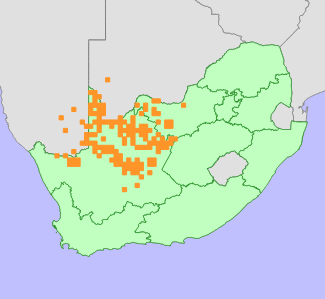|
Scientific Name | Aptosimum albomarginatum Marloth & Engl. |
Higher Classification | Dicotyledons |
Family | SCROPHULARIACEAE |
National Status |
Status and Criteria | Least Concern |
Assessment Date | 2024/02/12 |
Assessor(s) | N.N. Mhlongo & L. von Staden |
Justification | This species has an extent of occurrence (EOO) of 374 435 km² and an area of occupancy of 1184 km². It is widespread and abundant, with no severe threats. It is therefore listed as Least Concern. |
Distribution |
Endemism | Not endemic to South Africa |
Provincial distribution | Northern Cape, North West |
Range | This species can be found in the North West and Northern Cape provinces in South Africa and extends into Namibia. It also occurs in Botswana. |
Habitat and Ecology |
Major system | Terrestrial |
Major habitats | Kalahari Karroid Shrubland, Lower Gariep Alluvial Vegetation, Zeerust Thornveld, Eastern Upper Karoo, Northern Upper Karoo, Upper Karoo Hardeveld, Mafikeng Bushveld, Bushmanland Basin Shrubland, Molopo Bushveld, Bushmanland Arid Grassland, Lower Gariep Broken Veld, Bushmanland Vloere, Southern Kalahari Mekgacha, Highveld Alluvial Vegetation, Upper Gariep Alluvial Vegetation, Western Upper Karoo, Vaalbos Rocky Shrubland, Auob Duneveld, Gordonia Kameeldoring Bushveld, Gordonia Duneveld, Kuruman Thornveld, Kuruman Vaalbosveld, Moot Plains Bushveld, Schmidtsdrif Thornveld, Nossob Bushveld, Kimberley Thornveld, Stella Bushveld, Gordonia Plains Shrubland, Postmasburg Thornveld, Olifantshoek Plains Thornveld, Kathu Bushveld, Ghaap Plateau Vaalbosveld |
Description | Plants grow in sandy or gravelly flats. |
Threats |
| The root, stem and levaes of this species are used as traditional medicine by the Khomani Bushmen (Mannetti, 2011). Some parts of this species' range may be vulnerable to habitat loss and degradation to urban development (housing and dam infrastructural developments) and mining. |
Population |
No quantitative data are available for this species but it is known to occur in at least 50 subpopulations. There are 78 herbaria collections of this taxon with the date range from 1886 to 2015, along with 20 recent observation records on iNaturalist. The population trend is inferred to be stable.
|
Population trend | Stable |
Assessment History |
Taxon assessed |
Status and Criteria |
Citation/Red List version | | Aptosimum albomarginatum Marloth & Engl. | Least Concern | Raimondo et al. (2009) | |
Bibliography |
Botes, P.J.J. 2020. Botanical Assessment. Gariep Housing Project: Proposed formalization and development of 135 new erven on plot 113, Gariped settlement. !Kheis Local Municipality, Northern Cape Province. PB Consult Environmental Management Services, Bredasdorp.
Ekotrust. 2020. Botanical survey: Turksvydam project, Upington.
Mannetti, L. 2011. Understanding plant resource use by the Khamani Bushmen of the southern Kalahari. M.Sc dissertation, University of Stellenbosch, Stellenbosch.
Philcox, D. 1990. Scrophulariaceae. In: E. Launert and G.V. Pope (eds). Flora Zambesiaca 8 (Part 2):1-179. Flora Zambesiaca Managing Committee, London.
Raimondo, D., von Staden, L., Foden, W., Victor, J.E., Helme, N.A., Turner, R.C., Kamundi, D.A. and Manyama, P.A. 2009. Red List of South African Plants. Strelitzia 25. South African National Biodiversity Institute, Pretoria.
|
Citation |
| Mhlongo, N.N. & von Staden, L. 2024. Aptosimum albomarginatum Marloth & Engl. National Assessment: Red List of South African Plants version 2024.1. Accessed on 2025/12/05 |
 Comment on this assessment
Comment on this assessment


